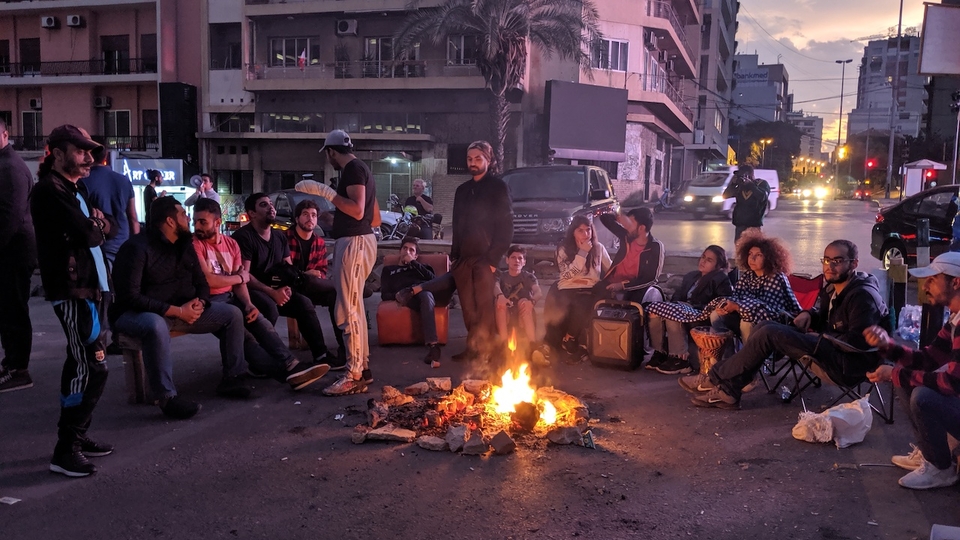What Mapping Collective Action Tells Us About the Lebanon Protests
Day 64: Thursday, December 19, 2019
Three months in, Lebanon’s popular mobilizations are considered unprecedented in the country's history, namely due to protesters’ stamina, large crowds, territorial spread across the country and among the diaspora, and nature of the discourse (socio-economic demands, fighting corruption, and denouncing collusion between the political and business/financial elites). But it would be erroneous to consider these mobilizations as entirely new, or as the direct result of single, punctual grievances.
Mapping collective action events over time is crucial for contextualizing the current protests. Not only does it challenge prominent readings of this latest cycle, it also contributes to new forms of practicing politics and engaging in the political sphere in Lebanon.
One such project is the Map of Collective Actions in Lebanon published by research centre Lebanon Support. It tracks collective action events across time and classifies them according to the following categories: actors/mobilizing structures and allies (if any); grievances and causes; objectives; modes of action; spatial characteristics; and state response. Data collection for this project started in 2017, but the center had been documenting collective action since 2014 — albeit not using the aforementioned detailed classification — as part of efforts to map conflict (based on a socio-political understanding of conflict as contention, not just belligerence or violence). In 2019, 200 mobilizations had already taken place before October 17. The number swells to 2,102 by the end of the year. These mapping exercises reveal that the October protests follow a steady increase in incidents of collective action around socio-economic demands, driven by years of corruption, clientelism, neglect of the peripheries, and more recently, austerity measures: 324 collective actions were mapped in 2015, 468 in 2016, 419 in 2017, and 188 in 2018. Coinciding with the much delayed parliamentary elections, 2018 saw a decrease in collective action in favor of different forms of political action. In 2019, 200 mobilizations had already taken place before October 17. The number swells to 2,102 by the end of the year. As this infographic illustrates, the most recurrent demands over the past three years are access to socio-economic rights and "policy grievances" (i.e. those associated with political decisions and government policies regarding matters of public concern). An infographic of the mobilizations between June 2014 and May 2015 highlights how the majority of mobilizations during this period were linked to policy issues and socio-economic development, challenging readings that claim they were driven by confessionalism.
Moreover, the demands of the October protests echo and build on those of previous cycles of mobilization, such as the 2015 movement around the waste management crisis or the 2011 protests demanding the fall of the sectarian system. This pattern highlights that social mobilizations are also cumulative, built on past episodes and generalized demands, rather than linked to punctual causes.
In addition to helping us understand the causes motivating the protests, the data sheds light on their modes of action. For example, returning to this infographic: road closures were the method of choice of protesters in 2014-2015. Indeed, this mode of action has consistently been one of the most preferred by protesters in Lebanon; it ranks as one of the top three most used between 2017 and October 16, 2019, as well as between October 17 and November 18, 2019. This point has been largely absent from the recent debate and controversy surrounding the use of road blockades by protesters.
New archiving and documentation projects have emerged since the October Revolution. For example, this open source map by Marc Farra and Majd al-Shihabi tracks the locations of protests across the world. Crucially, its open source nature provides a medium for broad participation in creating a live digital record of events — anyone can contribute to the exercise by filing reports on incidents, which are then verified. Such participatory and openly accessible mappings fill an important gap in information provision and collection, in the context of a no data policy in Lebanon – the last population census was made in 1932 – and given the lack of availability of and accessibility to official information, evident in public administrations’ response to information requests (see the work of Gherbal Initiative on this). By contributing to building and disseminating alternative narratives that are evidence-based, documentation initiatives can counter mainstream and unfounded narrativesThe new data being produced and made accessible can be used as evidence in campaigns and lobbying for progressive policy. It can also be considered as a form of archival activism, or the use of archiving in progressive political agendas to challenge dominant narratives and shed light on communities’ voices and struggles. The data can magnify the voices of all those who are mobilizing, thereby addressing gaps in mainstream coverage and documentation, and contributing to “re-appropriat[ing] control over the writing of ‘one’s own story’ as part of a wider process of cultural liberation” (Stuart Hall, 2004). By contributing to building and disseminating alternative narratives that are evidence-based, documentation initiatives can counter mainstream and unfounded narratives, especially in a context of disinformation traveling quickly through social media and WhatsApp groups.
Yet an important limit of this data bears mention, especially amidst heightened excitement for all things data: correlation does not necessarily imply causation, and it is important to combine analytical readings relying on quantitative data with contextual analysis and fieldwork, in order to avoid making spurious correlations.
In the midst of the struggle for new forms of practicing politics and engaging in the political sphere in Lebanon, relying on verified data and evidence-based research and analysis is necessary to inform alternative narratives, campaigning, lobbying, public action, and ultimately policy.
